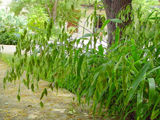Native Plants

Q. Who is Mr. Smarty Plants?
A: There are those who suspect Wildflower Center volunteers are the culpable and capable culprits. Yet, others think staff members play some, albeit small, role. You can torture us with your plant questions, but we will never reveal the Green Guru's secret identity.
Did you know you can access the Native Plant Information Network with your web-enabled smartphone?
Ask Mr. Smarty Plants is a free service provided by the staff and volunteers at the Lady Bird Johnson Wildflower Center.

rate this answer
Tuesday - November 01, 2011
From: Watauga, TX
Region: Southwest
Topic: Groundcovers, Shade Tolerant, Grasses or Grass-like, Herbs/Forbs
Title: Shade tolerant groundcover plants for Tarrant County, Texas
Answered by: Nan Hampton
QUESTION:
I live in far NE Tarrant County (Ft Worth), TX and need a groundcover that can tolerate complete shade and poor, rocky, clay soil. I need mostly for erosion control, and needs to be relatively lowANSWER:
Here are several groundcovers that will grow in the shade. Except for the two grasses, they are semi-evergreen or evergreen.
Calyptocarpus vialis (Straggler daisy) is evergreen to semi-evergreen. "Evergreen in areas with mild or no winter, deciduous in areas with cold winters."
Phyla nodiflora (Texas frogfruit) is semi-evergreen.
Packera obovata (Golden groundsel) is evergreen to semi-evergreen.
Carex planostachys (Cedar sedge) is evergreen.
Chasmanthium latifolium (Inland sea oats) dies back in winter but is perennial. This grass grows in clumps and can reach 2 feet or more, but is very attractive.
Muhlenbergia schreberi (Nimblewill) dies back in winter but is perennial.
From the Image Gallery
More Herbs/Forbs Questions
Invasive thistles in wildflower field from Dripping Springs TX
February 17, 2014 - How to get rid of "native" thistles.. I have a large natural field that used to grow a variety of wildflowers, but in 2011 and 2012 it was taken over by thistles. I'm sure they are "native" Texas...
view the full question and answer
Plants for underneath oak tree
October 10, 2012 - I have a North facing wall of my house that gets half sunlight half shade depending on the season. I would like to layout some native South Texas plants and complete fill in area to prevent the live o...
view the full question and answer
Need suggestions for material to build a raised bed garden
February 13, 2015 - I am starting a raised bed garden but cannot find untreated railroad ties or landscape timbers. Does anyone have a source in the Austin or Dripping Springs area? I have tried McCoys, Home Depot, Natur...
view the full question and answer
Non-native invasive henbit from Round Rock TX
April 27, 2013 - I've read in this book "Native Alternatives to Invasive Plants" that Henbit is an invasive plant in Texas. I've also read that it provides an early source of nectar to bees and butterflies when li...
view the full question and answer
Perennial Suggestions for Under Ash Trees in Minnesota
June 12, 2013 - With our house we have inherited 2 ash trees in our front yard with a large amount landscaping underneath. I'm replacing the landscaping but there are tree roots at the surface preventing me from bei...
view the full question and answer
| Support the Wildflower Center by Donating Online or Becoming a Member today. |

